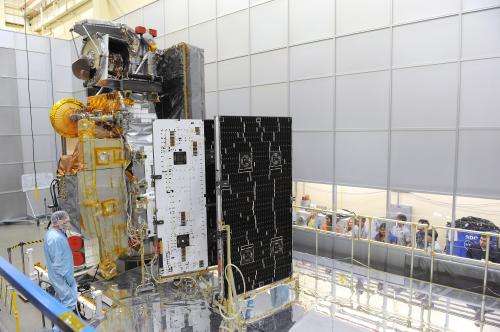GPM spreads its wings in solar array deployment test

(Phys.org) —NASA successfully completed two pre-vibration solar array deployment tests of the Global Precipitation Measurement satellite on June 6 and June 15, 2013.
"Cross your fingers. Cross your toes," said Art Azarbarzin, GPM project manager, as he watched engineers take their places around the GPM Core satellite, set up on its end in the middle of the clean room.
A loud hiss filled the room as engineers turned on air hoses. The hoses pumped air through tubes attached to the solar panels' supports and out of hockey puck-shaped coasters. Azarbarzin explained that the support system and air cushion is designed to reduce friction and best mimic how the solar array would float in space.
Next, a man's voice from the adjacent control room started to count down. Five seconds later, five loud pops sounded one after the other. The pops resulted from the triggering of Frangibolts, which discharge in small, controlled explosions to release the solar array. After the loud pops sounded, the four panels of the array started to slowly unfold like an accordion, until the wing fully extended across the floor.
The solar array panels and boom, a large support beam running across the back of the first two solar panels, locked into place. Engineers inspected the solar array front and back, closely examining the panels' junctions and wires. After confirming the array was successfully deployed, they manually unlocked and folded the solar array back into the body of the spacecraft.
The GPM Core will orbit Earth at an angle that enables the satellite to observe the globe from the Antarctic Circle to the Arctic Circle. Its orbit will also cross the paths of other satellites that will contribute data to the GPM mission's global precipitation data set.
To increase the satellite's exposure to the sun, the GPM Core has two solar wings. Each wing has four panels, and each panel has between 800 and 1,200 solar cells. Together, the two wings provide a total of 2,000 watts. The arrays convert solar energy to electricity, which help power spacecraft electronics and the satellite's two instruments, the GPM Microwave Imager and the Dual-frequency Precipitation Radar. Excess power charges the satellite's battery, which is used when the GPM Core isn't in direct sunlight.
The solar array wing deployments are part of the GPM Core satellite's series of environmental tests. The thermal vacuum test that simulates temperature changes in the vacuum of space was completed in early February, and the electromagnetic interference test that assures all elements of the satellite work together was performed in May. The Core satellite will also undergo the vibration and acoustic test, which simulate rocket vibration during launch, and shock and separation test, which simulates inducted shock to the satellite when being separated from the rocket. A final solar array deployment test will be conducted following the completion of the environmental test program to assure that the solar arrays will survive the launch environment and deploy successfully.
The GPM Core, the largest satellite built and tested at Goddard, is scheduled to launch in February 2014 from Japan. The GPM Mission is a collaboration between NASA and the Japan Aerospace Exploration Agency, measuring rain and snow worldwide every three hours. GPM data will advance understanding of Earth's water and energy cycles, enhance the forecasting of extreme events that cause natural disasters, and improve researchers' ability to use satellite precipitation information to directly benefit society.
Provided by NASA's Goddard Space Flight Center




















